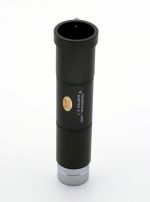Star diagonals
Star diagonals – mirror and prism versionsWhen you point a refractor telescope, Schmidt-Cassegrain telescope or Maksutov telescope at the night sky, one stands out: The focuser points downwards. The prism variant has a triangular shaped prism, like the roof of a house. The base of this ‘roof’ is positioned at 45° so that the shorter faces are perpendicular to the incoming and outgoing light. Now, when a light beam hits the longer side it is deflected by 90° and into the eyepiece. A star diagonal using a mirror works in a similar way. It consists of a mirror which is oriented in the housing in exactly 45°. So the prism and mirror versions both have the same effect. The light path in the prism is slightly longer and poor quality prisms are prone to chromatic aberration. With mirror star diagonals however, it is important that they have a high reflectance. There are now so-called dielectric mirrors that reflect up to 99% of the incident light. Compared to ‘normal’ mirrors, these provide a brighter and higher contrast image. The only telescope that does not need a star diagonal is the Newtonian reflector. The focuser points sideways out of the top of the telescope, so that you never have to crane your neck with this type of telescope. Inverted images can be quite irritating when you are trying to find an object in the night sky. You tend to move the telescope in the wrong direction. These orientation problems become easier as one gains experience with handling a telescope and it eventually is no longer a problem. The image produced by a refractor is quite different from that seen in a Newtonian reflector. In order to clarify this confusion, take a look at this list:
In order to obtain an upright and left-right correct view with a refractor or Schmidt-Cassegrain, you will need an Amici prism. This accessory has a roof prism, which sets the image the right way up. This type of prism can also be found in binoculars for example. The Amici prism usually has a viewing angle of 45°, but they are also available as 90° prisms. Example for star diagonal and Amici prism The erecting lensAn erecting lens has a very similar effect to an Amici prism. The erecting lens turns an upside-down image the right way up again, allowing you to use an astronomical telescope for terrestrial viewing. This lens is often not a single lens, but a system consisting of several lens elements. It usually has four lens elements, in which two lens elements are cemented together. The cemented systems consist, for example, of a plano-concave and a bi-convex lens. A defined separation of elements generates a magnification factor of 1.5X in addition to the re-inverting of the image. The most serious chromatic aberration is also corrected for. However, an erecting lens is a compromise. The image scale is often changed adversely. Also, these lenses are usually not coated so that one has to reckon with some light loss. However, there are also high-quality systems whose optical quality is particularly good and where the lenses are fully coated. One should stick to buying these high quality lenses. |
|

